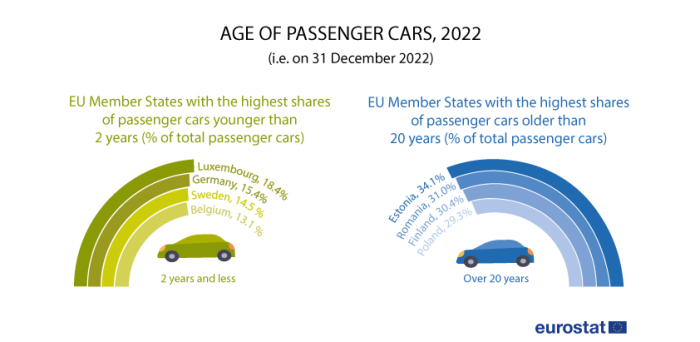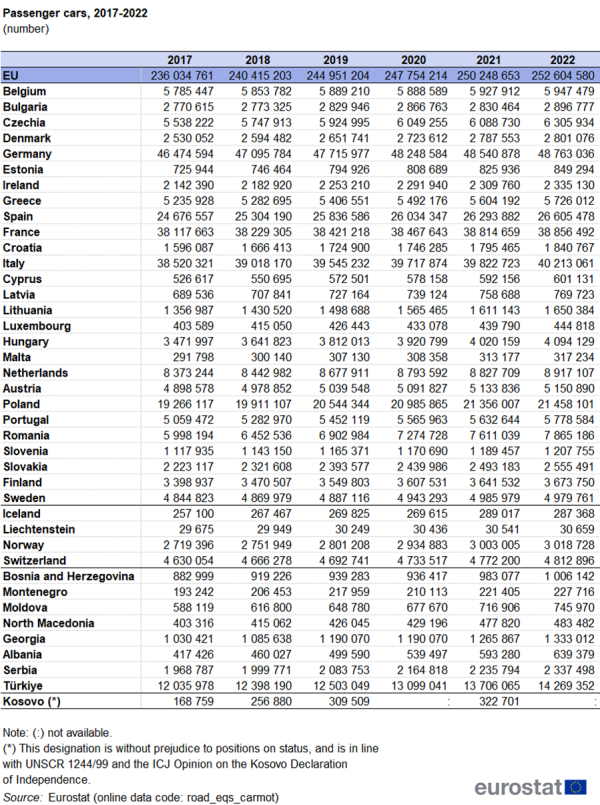Passenger cars in the EU
Data extracted in December 2023
Planned article update: 2 August 2024
Highlights
This article describes developments in passenger car stocks and new registrations in the European Union (EU), providing extended information on passenger cars powered by ‘alternative fuels’.
Full article
Overall, the passenger car fleet in almost all of the EU Member States has grown over the last five years, exceeding an EU total of 250 million cars (Table 2). The highest number of cars per thousand inhabitants was recorded in Italy, followed by Luxembourg and Finland (Figure 3). In 2022, Luxembourg had the highest share of 'youngest' vehicles, while Estonia had the highest share of passenger cars older than 20 years, followed by Romania and Finland (Figure 5).
Despite an increase over the last years, passenger cars powered by alternative fuels only made up a small share of the new registration of passenger cars in the EU in 2022 (Table 1). This is reflected by the share of cars powered by alternative fuels being low among the newly registered passenger cars (Figure 2).
However, in 2022 the number of battery-only electric passenger cars in the EU Member States exceeded 2.9 million, which was about 56 times higher than in 2013 and 7 times higher than in 2018. The highest rates of increase were noted between 2019 and 2020 (84.9 %) and between 2020 and 2021 (77.7 %). Their share in the total number of passenger cars grew from 0.02 % to 1.2 % (Figure 1).
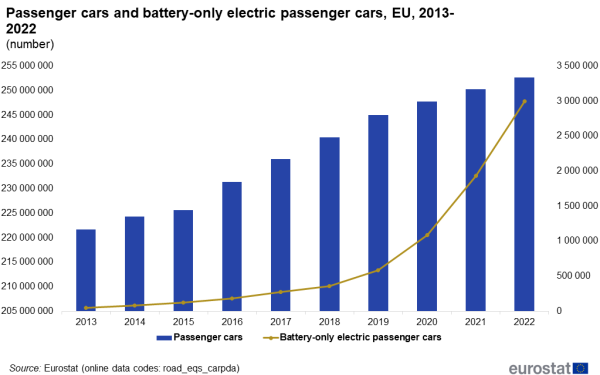
(number)
Source: Eurostat (road_eqs_carpda)
New passenger car engine fuel: petrol popular, diesel declining, alternative rising
The preferences for whether a new passenger car should be powered by a petrol or diesel engine vary across the EU Member States (Table 1). Of the 25 Member States for which detailed data are available, 24 registered a higher petrol share; this is an accentuation of the phenomenon observed in 2017 (until 2015, the majority of Member States recorded a higher diesel share, in 2016 there was the same number on both sides).
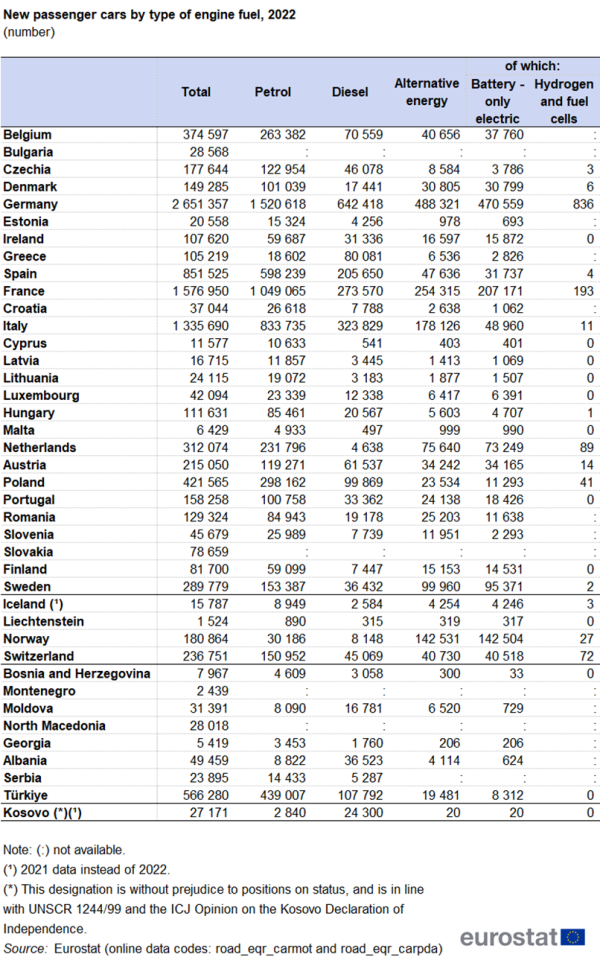
(number)
Source: Eurostat (road_eqr_carmot) and (road_eqr_carpda)
In 2022, the highest shares of petrol-powered cars among the new registrations were noted in Cyprus (91.8 %), Lithuania (79.1 %), Malta (76.7 %) and Hungary (76.6 %), with high shares also recorded in Estonia (74.5 %), the Netherlands (74.3 %), Finland (72.3 %), Croatia (71.9 %), Latvia (70.9 %), Poland (70.7 %, Eurostat estimates), Belgium and Spain (both 70.3 %), Czechia (69.2 %), Denmark (67.7 %), France (66.5 %), Romania (65.7 %), Portugal (63.7 %), Italy (62.4 %), Germany (57.4 %), Slovenia (56.9 %), Austria and Ireland (both 55.5 %), Luxembourg (55.4 %) and Sweden (52.9 %).
By contrast, the only country that recorded a higher share of diesel cars among new passenger cars was Greece (76.1 %).
In the EU Member States, EFTA countries, candidate countries and the potential candidate for which recent data are available, an increase in the share of new registrations of passenger cars powered by alternative fuels can generally be observed in the last three years (Figure 2). In 2022, this share became majority in Norway (78.8 %) and exceeded 10% in Germany (18.4 %), Switzerland (17.2 %), France (16.1 %), Austria (15.9 %), Malta (15.5 %), Ireland (15.4 %), Portugal (15.3 %), Luxembourg (15.2 %), Italy (13.3 %) and Belgium (10.9 %). As it can be deduced from Table 1, in 2022, the share of alternative fuels overtook the diesel share in Sweden (34.5 % vs. 12.6 %), Iceland (26.9 % vs. 16.4 %, 2021 data), the Netherlands (24.2 % vs. 1.5 %), Liechtenstein (20.9 % vs. 20.7 %), Denmark (20.6 % vs. 11.7 %), Romania (19.5 % vs. 14.8 %) and Finland (18.5 % vs. 9.1 %).
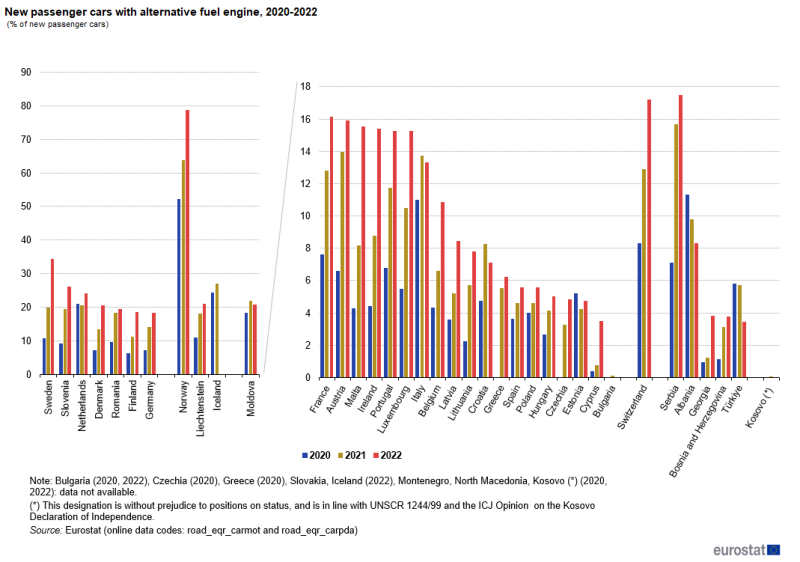
(% of new passenger cars)
Source: Eurostat (road_eqr_carmot) and (road_eqr_carpda)
The government incentives to stimulate the share of cars with lower emissions include, for example, tax reductions, subsidies or specific privileges such as access to lanes reserved for public transport and free parking. Other main reasons are the number and variety of passenger car models with alternative fuel engines offered, as well as the prices of such models.
A 7 % increase in EU-registered passenger cars since 2017
In 2022, the number of the EU-registered passenger cars reached almost 253 million, corresponding to an increase of 7.0 % as compared with 2017. The highest number of registered passenger cars was observed in Germany with almost 49 million cars. Followed by Italy (40 million cars) and France (39 million cars). Over the five-year period from December 2017 to December 2022, there was a strong growth in the number of registered passenger cars in several of the Member States. The highest growth over this period was recorded in Romania (31 %), followed by Lithuania (22 %), Hungary (18 %), Estonia (17 %), Croatia and Slovakia (both 15 %), Portugal, Cyprus and Czechia (all three 14 %), as well as Latvia (12 %).
Amongst the EU Member States with the highest motorisation rates, i.e. passenger cars per thousand inhabitants, there are several smaller countries (Figure 3). Italy heads the list (684 passenger cars per thousand inhabitants) and in second place follows Luxembourg with 678 cars per thousand inhabitants (Figure 5). Other countries with a high motorisation rate include Finland (661 cars), Cyprus (658 cars), and Estonia (637 cars).
These EU Member States are overtaken by two EFTA countries: Liechtenstein (775 cars) and Iceland (749 cars), while the other two EFTA countries, Norway (553 cars) and Switzerland (547 cars), are close to the EU average (560 cars).
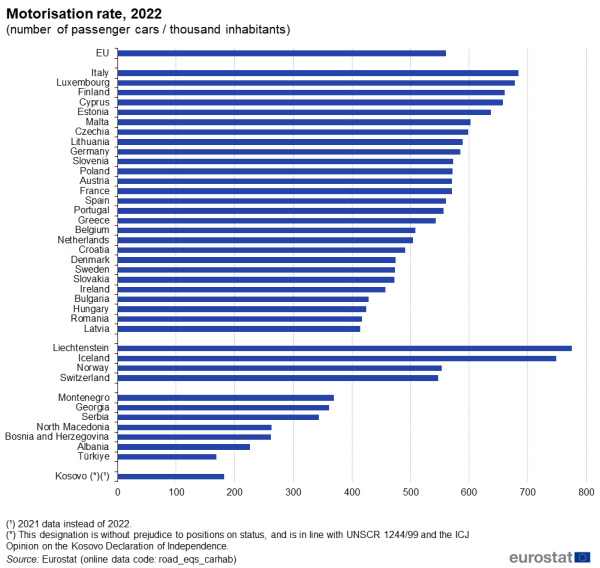
(number of passenger cars / thousand inhabitants)
Source: Eurostat (road_eqs_carhab)
At the other end of the scale, a particularly low motorisation rate is recorded in Latvia (414 cars), despite a growth in the number of registered cars of 12 % over the period 2017-2022.
The motorisation rate in the EU candidate countries and potential candidate for which data are available (Montenegro, Georgia, Serbia, North Macedonia, Bosnia and Herzegovina, Albania, Türkiye, and Kosovo*) is substantially lower than in the Member States. The smallest value, 169 cars per thousand inhabitants, was recorded in Türkiye.
*Kosovo: This designation is without prejudice to positions on status, and is in line with UNSCR 1244/99 and the ICJ Opinion on the Kosovo Declaration of Independence.
Small petrol engines more common than medium-sized and large engines
In 12 of the 23 Member States for which information is available for 2022, there were more petrol cars than diesel cars, with the share of petrol cars ranging from 85 % in the Netherlands to 47 % in Italy (Figure 4). In the other 11 Member States, diesel cars outnumbered petrol cars with their shares ranging from 67 % in Lithuania to 50 % in Romania and Slovenia. Despite efforts across Europe to increase the share of cars with low CO2 emissions, the share of passenger cars powered by alternative fuels remained low in 2022 in most Member States. In 3 out of 23 Member States for which information is available, passenger cars using alternative energy represented less than 1 % of the total passenger car fleet. The EU Member State with the highest share is Italy, where the passenger cars powered by alternative fuels reached 10.0 % in 2022. Other countries with notable shares of passenger cars using alternative fuels are Norway (20.1 %), Sweden (8.3 %), Lithuania (7.1 %) and Latvia (5.7 %). Among candidate countries and the potential candidate, the highest share of passenger cars of alternative fuels was registered in Türkiye (35.4 %), Georgia (32.7 %) and Moldova (16.8 %). In Norway almost all (99.9 %) of the passenger cars of alternative fuels are battery-only electric passenger cars while in Türkiye and Moldova the share of LPG cars is dominant among the passenger cars of alternative fuels.
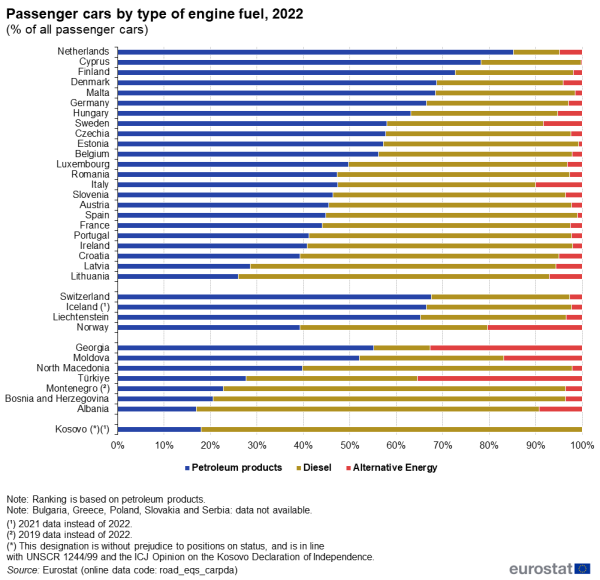
(% of all passenger cars)
Source: Eurostat (road_eqs_carpda)
In 15 out of 21 EU countries for which data are available, it can be noticed that the share of small petrol engines is higher than the share of the medium- and large-sized ones (Table 3).
In Malta, in 2022, more than half of all passenger cars had small petrol engines, with the share of cars with small-sized petrol engines reaching 55.7 % of the total, followed by the Netherlands with 51.7 %. In Finland, medium-sized petrol engines powered 39.4 % of the passenger cars. The highest shares of large petrol engines can be found in Estonia (10.7 % of all passenger cars) and Finland (9.1 %); and in the EFTA countries, in Liechtenstein (16.5 %) and Switzerland (10.8 %).

(number and % share of all passenger cars)
Source: Eurostat (road_eqs_carmot)
Overall, passenger cars with small engines generally use petrol as fuel; there are relatively few passenger cars with small diesel engines in the EU. Medium-sized engines dominate amongst the diesel-powered passenger cars in all Member States for which data are available (Table 4). This is particularly the case for the group of countries with the highest overall share of diesel-powered passenger cars (Ireland, France, Portugal, Austria, Croatia and Spain). However, for Latvia, which has an even higher proportion of diesel-powered vehicles than the countries in the group, the share of large motor engines (> 2000 cm3) is quite significant (25.8 %).
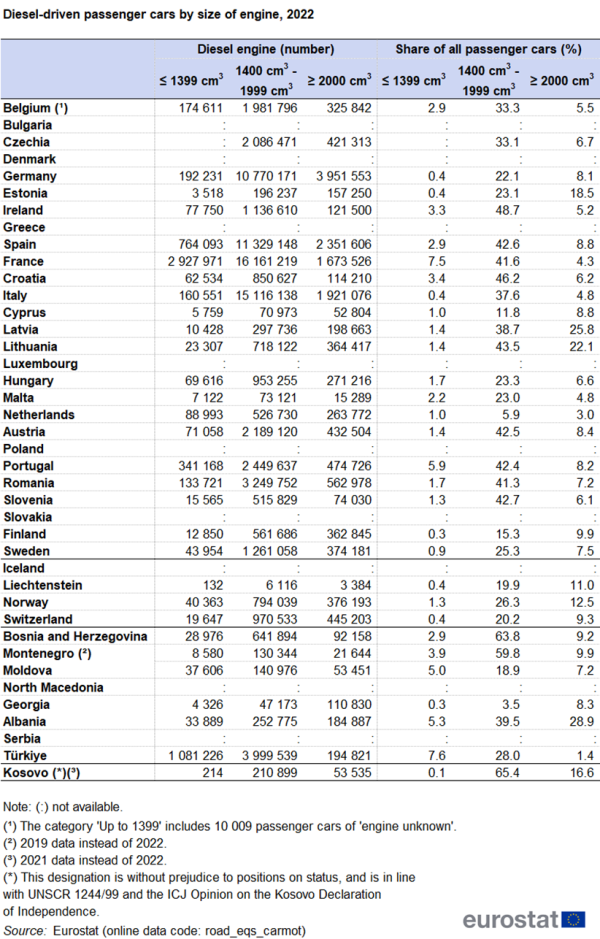
(number and % share of all passenger cars)
Source: Eurostat (road_eqs_carmot)
The shares of the ’youngest’ passenger cars (less than 2 years old) were highest in Luxembourg (18.4 %), Germany (15.4 %), Sweden (14.5 %), Belgium and Ireland (both 13.1 %) and Austria (13.0 %). By contrast, several Member States reported a large share of ’old’ passenger cars (20 years or older) in 2022, see Figure 5. The Member States with the highest shares were Estonia (34.1 %), Romania (31.0 %), Finland (30.4 %), Poland (29.3 %), Portugal (26.4 %) and Malta (25.6 %).
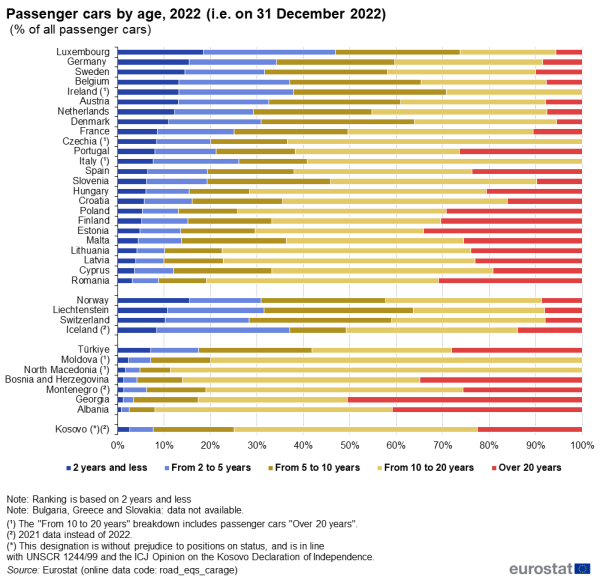
(% of all passenger cars)
Source: Eurostat (road_eqs_carage)
In recent years, several countries have been offering programmes supporting the purchase of new cars with low emissions while scrapping the owners’ old cars. The general aim of these programmes has been the renewal of the passenger car fleet with lower emission cars, while simultaneously stimulating the economy. These programmes have had a certain influence on the age composition of passenger cars in individual countries. In this context, one should take note of the reference year when analysing these data. Figure 6 presents the age distribution of passenger cars in 2022 (i.e. on 31 December 2022).
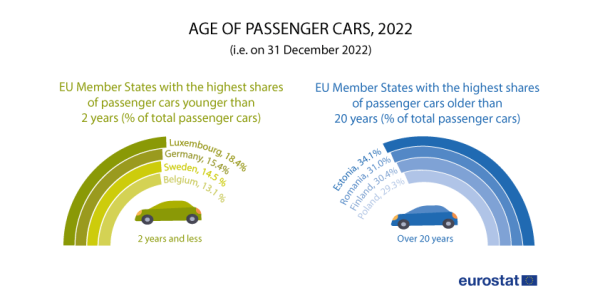
(% of all passenger cars)
Source: Eurostat (road_eqs_carage)
Source data for tables and graphs
Data sources
The Eurostat/ITF/UNECE Common Questionnaire on Inland Transport Statistics.
Coverage
The data in this article covers the EU Member States, the EFTA countries and the candidate countries and potential candidate (list of countries and the corresponding country codes).
Definitions
All definitions used are taken from the Eurostat/UNECE/ITF Glossary for Transport Statistics, currently in its 5th edition. This glossary can be found on Eurostat’s website Eurostat/UNECE/ITF Glossary for Transport Statistics.
Passenger cars
Road motor vehicle, other than a moped or a motor cycle, intended for the carriage of passengers and designed to seat no more than nine persons (including the driver).
Included are:
- Passenger cars
- Vans designed and used primarily for transport of passengers
- Taxis
- Hire cars
- Ambulances
- Motor homes
- Micro-cars (needing no permit to be driven)
Excluded are light goods road vehicles, as well as motor-coaches and buses, and mini-buses/mini-coaches.
New motor vehicles registered during the year
The new motor vehicles registered during the year are those motor vehicles that are first-time registered as new in a motor vehicle register, irrespective of the nationality of the register. The imported second-hand vehicles are not first-time registered but should be regarded as reregistered vehicles. Thus, should not be included in the number of new motor vehicles registered first time during the year.
Motor energy
The principal type of motor energy used by the vehicle as certified by the competent authority of the country of registration. For hybrid or dual-fuelled vehicles adapted for using more than one type of motor energy (e.g., LPG and petrol, or electricity and diesel, etc.), the principal type of motor energy should be, where possible, an alternative fuel.
Alternative fuel
A type of motor energy other than the conventional fuels, petrol and diesel. Alternative fuels include electricity, LPG, natural gas (NGL or CNG), alcohols, mixtures of alcohols with other fuels, hydrogen, bio-fuels (such as biodiesel), etc. (this list is not exhaustive). Alternative fuels do not include unleaded petrol, reformulated petrol or city (low-sulphur) diesel, neither hybrid petrol-electric nor hybrid diesel-electric motor energy.
Motorisation rate
The number of registered passenger cars per 1000 inhabitants.
Context
The Common Questionnaire on Inland Transport Statistics is a joint project of Eurostat, the International Transport Forum (ITF) and the United Nations Economic Commission for Europe (UNECE). The data are provided on a voluntary basis by a large number of countries, both within and outside the European Union. Data is collected from reliable sources, but data collection methodologies are not harmonised at EU level. Comparability across countries is restricted as the classifications used in the national vehicle registers are not harmonised. Vehicle registers may exclude taxis, pick-ups and vans from the definition of “passenger cars”, and may also exclude very old vehicles. This article covers data provided by the EU Member States, the EFTA countries and EU candidate countries and the one potential candidate.
Direct access to
Database
- Transport, see:
- Road transport (road)
- Road transport equipment - Stock of vehicles (road_eqs)
- Road transport equipment - New registration of vehicles (road_eqr)
- Common Questionnaire for Inland Transport Statistics (ESMS metadata file — rail_if_esms)
- Eurostat/UNECE/ITF Glossary for Transport Statistics, 5th edition
- Roadmap to a single European transport area – towards a competitive and resource efficient transport system (European Commission White paper: COM(2011) 144 final)
- Handbook on statistics on road traffic - Methodology and experience (UNECE, 2007)
